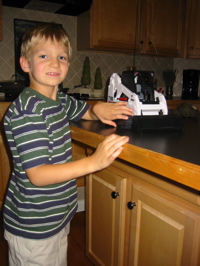
In 2006, Corey was diagnosed with paracentral pachygyria, a mild form of Lissencephaly through research studies done by Dr. Dobyns at the University of Chicago and Dr. Walsh and Dr. Chang at the Walsh Laboratory using his MRI film taken in 2005 after a series of seizures.
We knew Corey had a brain malformation from his first MRI done in 2001. At that time the doctor did not show us the MRI and said Corey had mild hypotonic Cerebral Palsy and by the time he was 8 no one would know the difference.
Several years later a different doctor showed us the MRI for the first time and explained that Corey had “fewer folds” and that it could lead to some form of mental retardation but was not sure to what degree. We were concerned with treating his seizures and held onto the hope from the first doctor’s outlook. Corey did not seem like a child with mental delays only speech and motor delays. Other therapists said he was smart and those who took the time to listen to him.
In 2005 when the second MRI came back another doctor said nothing had changed from the first one but the words had changed and described “many folds“. It also had the description of Perisylvian Syndrome, which was new to us. Our current doctor had not seen Corey’s brain malformation before and said it was rare.
Wanting more information on the new diagnosis we searched the internet, connected with others and some suggested having Dr. Dobyns review our MRI. Then around the same time a friend of a friend suggested we look at www.Clinicaltrials.gov for more information. I found Dr. Dobyns under the brain malformations research and requested his review of Corey’s MRI to see if he could participate in the study. Several months had passed without hearing from him. We found out the paper records were being sent not the film and once the correct MRI film was sent he responded with the information below. During the time we were waiting I found the Walsh Laboratory clinical trial and requested a review from them. Both doctors came back with the same diagnosis – Pachygyria.
My husband went onto the Lissencephaly site on a weekend to find more information. He found that children are expected to live only to the age of 20 among other things and was completely distraught. More than I had ever seen him in any diagnosis we had received up to this point.
We were so grateful and relieved to hear back from another parent and later the doctors that Corey could have a full life and the Lissencephaly site or the internet as a whole did not have information about Corey’s form of Pachygyria. I had already begun this website and knew this was a chance to help some other family not go through the same emotional rollercoaster that we did.
Hopefully we can find each other and learn through each other. If your child has these words or similar descriptions on their MRI please contact me through the comments button below or email me privately at Candice@sophtware.com. I have found two other families through Dr. Dobyns and Walsh Laboratories at this writing in October of 2006. As of October 2007 I still only know of these two families and three genetic testings have been done.
As of March 2009, there have been about 10 families from around the world that have been in contact with me since the site began.
2017 and the world of Facebook has connected more than 200 families from around the world with pachygyria.
————————————————————————
Email clippings from Dr. Dobyns at University of Chicago for Corey, 2006-7
The correct diagnosis is “paracentral pachygyria“, a mild form of Lissencephaly.
The term Perisylvan Syndrome refers to a similar malformation known as Polymicrogyria. So this is very similar, but not quite the same thing.
Hypotonic Cerebral Palsy is a non-specific label that could be used as a secondary diagnosis.
The Lissencephaly website mentions heart problems but this variant does not have heart problems and is not relevant for Corey. No EKG needed.
The Lissencephaly website mostly does not apply. The internet does not have information on this form of Pachygyria.
For reproduction, we will need to see when he grows up. But he might pass the disorder on, possibly, not sure. (The Lissencephaly site said they can not reproduce.)
Degenerative or regressive? Highly unlikely, except seizures can become a problem.
Corey’s brain scan shows a very rare, relatively mild variant of lissencephaly (LIS), in which a less severe degree of LIS known as Pachygyria (“thick cortex”) affects the middle and posterior parts of his brain. To compare this for you, this involves about 1/2 of his brain with the cortex (nerve cell layer) about 2x normal thickness, while the typical forms of LIS affects 90-100% of the brain with a cortex about 4x the normal thickness.
Complete MRI description
LIS4pa variant. MRI at 6y on CD shows nearl normal gyral pattern anteriorly, mod pachygyria over posterior frontal lobe-perisylvian- posterior temporal lobe-parietal lobe, most severe over perisylvian-parietal lobe, mod thick 6-10 mm cortex in most severe areas, normal hippocampus, basal ganglia and thalamus, thin white matter, mildly enlarged lateral ventricles posteriorly, normal corpus callosum, brainstem and cerebellum, and minimally enlarged cisterna magna. This is the mild perisylvian-posterior variant of LIS.
I don’t have a good name for this disorder yet; I just code it as mild (grade 4) posterior LIS or Pachygyria.
I have reviewed scans on only two other children with this rare subtype, out of more than 1,000 that I have reviewed over the years. This disorder is associated with developmental handicaps and epilepsy, but less severe than the typical forms of LIS. … Neither of the other children had any other birth defects.
I do not know the cause of this particular condition. The three children are all boys with no affected sibs. But this is too little information to draw any conclusions. He should have two genetic tests (2006 – in 2007 a 3rd test was developed) for LIS, consisting of (1) testing for deletions of chromosome 17 by FISH analysis, and (2) sequencing of the LIS1 gene. If negative, he would be very appropriate to add to our LIS research testing.
My focus is on finding the causes of PMG, so I focus on correct diagnosis of the malformation and overall syndrome. I have some experience with medical management, but this is variable because the severity of PMG is so great among different kids. So medical management is based more on the specific problems than on PMG per se.
If you would like to bring him to clinic, contact Tracy:
Tracy Holcomb 773-834-9110
tholcomb@genetics.uchicago.edu
WBD
William B. Dobyns, MD
The University of Chicago
PLEASE send a signed copy of our research Consent Form with all communications that include private health information, including all brain imaging studies, and with blood or DNA samples. Our current research information and Consent Form can be found on our website.
This email was posted with permission from Dr. Dobyns.
2007 Update:
We are testing several new genes in my research lab, on kids in whom the common clinical tests are negative. New genetic test called MLPA.
Corey has real LIS with a LIS1 pattern, although less severe than typical.
William B. Dobyns, MD
The University of Chicago
Moved to Seattle
————————————————————————
MRI Report
This is Corey’s MRI report from 1/12/2005 that was diagnosed with congenital perisylvian syndrome. The diagnosis was changed by Dr. Dobyns and he said it is a very easy mistake to make with the closeness in malformations.
Extensive neuronal migration disorder and congenital perisylvian syndrome(diagnosis term changed).
There is bilateral pachygyria involving the parietal region extending into the operculum bilaterally. The ventricles are small. No masses are identified.
File Keyword: Epilepsy, multifocal epilepsy/ generalized epilepsy/ cortical heterotopias / perisylvian syndrome (changed) (7/1/05)
————————————————————————
Walsh Laboratory
Adria Bodell with Walsh Laboratory said this was a fluke of nature and no matter what I had done during Corey’s pregnancy would not have caused this brain malformation. The malformation occurred within the first 3 months of Corey being conceived. This is also not going to spread into any other organs such as his heart. It is unknown if this will affect my daughter’s children unless we have genetic testing done on Corey.
It was also wonderful to find out that Corey will not die by age 20, which was found on the Lissencephaly sites. This is a very mild variant and he can have a long life. Walsh Laboratories also discovered a family in Turkey in September of 2006 with Pachygyria and DNA is being requested at this time for genetic testing. It can take years or months to find the chromosome link and more answers. There is hope and it is being researched currently.
Visit Walsh laboratory for information on the conditions they research at http://www.walshlab.org/fa_conditions.php
Contact Information
Christopher A. Walsh, MD, PhD
77 Ave. Louis Pasteur
NRB-0266
Boston, MA 02115
Phone: 617-667-0813
Fax: 617-667-0815
cwalsh@bidmc.harvard.edu
————————————————————————
Questions or Want to Connect? :
If you have any other questions about Pachygyria that have not been answered here or would like to connect, please make a comment or email me privately at Candice@sophtware.com.
Corey’s Picture
This is a picture of Corey just before his 8th birthday 10/2006. He loves Bobcat diggers and any construction vehicles, playing in the sandbox, how things work and chasing his younger sister.



